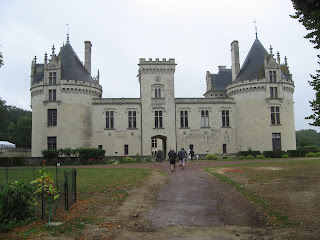Remember those delicious Charlotte strawberries we bought yesterday? They were part of our breakfast this morning to fortify ourselves before heading out to visit a local château. It was raining and cool, but we felt our first week of R&R (rest and relaxation) had come to an end.
Castles are not all the same. A visit to the Château of Brézé provides an opportunity to discover an elegant castle as well as its extraordinary underground fortress. Hidden beneath the château is one of the undiscovered marvels of the Loire Valley`s castles - a unique ensemble of buildings carved out of the rock! This troglodyte world of rock opens out onto the deepest dry moats in Europe, which reach a depth of 18 meters.
Me in front of the Château de Brézé.
Karl is in the doorway leading to the courtyard, and to his right and left are the dry moats.
In the tower, a beautiful display of saddles.
What it looks like under the roofs.
Overlooking the vineyards.
Seven League Boots. Used by the postillon (postman) who travelled seven leagues, or 30 km., between each station.
The entrance to the furnished rooms.
Karl posing to see if he's got what it takes to become a "bust".
This is the Bishop's Room. Pierre de Dreux-Brézé was born in the Château in 1811. In line with tradition, he studied theology in Italy and became a priest in 1834. In 1850, he was consecrated Bishop of Moulins, in the Allier department, and became one of the youngest bishops in France. At his death 43 years later, he was the oldest!
A dining set fit for the bishop.
His private little room for his ablutions.
The very ornate "prie-Dieu", a kneeler specifically made for prayers. I have often wondered if prayers from a skinny priest are more powerful than the ones from a corpulent priest because the bony knees suffer so much more with hours of kneeling.
The bishop's office. The walls are adorned with wood patterns and not wall-paper.
The bishop's desk.
The ceiling in the office.
The bishop's bed.
A guest room.
The fireplace, mantle clock, pitcher and bowl for ablutions in the guest room.
An exquisite armoire for clothes.
These are examples of the clothing worn by the staff. Very elegant, n'est-ce-pas?
The hallway on our way to the Great Hall is adorned with paintings and sketches of the time period.
The knobs to open the windows in that hallway, with the view of the rest of the château from this vantage point.
A decorative and artistic piece above the fireplace in the Richelieu room.
The tapestries are so beautiful!
Not sure what purpose this tiny room off the Richelieu room serves, but perhaps an opportunity to meditate. Small desk and chair barely fit in.
A "secrétaire" desk. When unlocked, the front panel comes down to create a table where finances or letters of importance can be written.
The bathroom was most interesting to me. Installed in 1860 - 1880, it is one of the most beautiful bathrooms of the 19th century in the Maine-Loire region. In royal bathrooms, there were 2 baths: one for washing, and one for rinsing off. This "bath cabinet" had just one bath. The two swan-neck taps, for hot and cold water, allowed the bath to be refilled quickly, thus providing clean water for rinsing.
The bath is made of zinc. A sheet is placed in it for sake of comfort and hygiene.
From the Renaissance to the 18th century, the West believed that dirt warded off disease. Water was held responsible for spreading diseases by penetrating the pores. People "dry-cleaned" themselves, by rubbing the visible parts of the body.
In the 19th century, the great scientific discoveries like those of Louis Pasteur influenced sanitary habits. The role of bacteria was discovered, and preventive measures recommended: washing hands, cleaning oneself with soap and water daily, vaccination, antiseptics, etc.
Here you have a taste of the period of optical illusions. The walls are "painted" to imitate marble. Furniture is simple and includes a straw seat chair (because of humidity) and a small item of furniture for laying towels on.
The water was heated by a wood or coal-burning stove. A curiosity: a very rare towel warmer!
One of two huge doors that open up to the Great Hall.
Even the chairs look like they belong in a church.
This bench is authentic and comes with a stern warning not to sit on it. Very fragile.
Although there are many framed portraits on the wall, I thought you would enjoy this one of "The Master of Ceremonies". He MUST know all the rules of what to wear and what pomp and circumstance is associated with each event. Look at the hat he's holding.
Another incredible door at the end of the Great Hall.
Now down in the lower levels of the Château.
Karl considers what it would be like in the "cachot", the dungeon jail.
Me, begging for food.
The Château de Brézé bears the mark of two architectural styles: the Renaissance in the 16th century and the Neo-Gothic in the 19th century. It is U shaped.
Talk about having the weight of the world on your shoulders!
This is the "douve", the dry moat.
Troglodyte means cave dweller and they lived deep underground.
A very interesting and educational tour. I must say, however, that the stairs were steep and narrow; not at all suitable for someone with mobility issues.
"The great use of life is to spend it for something that will outlast it."
~ William james


























































































































